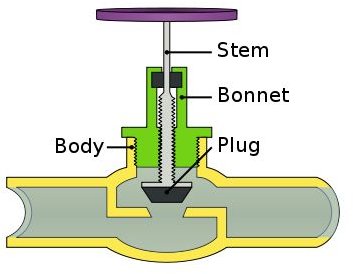Globe Valves
Table of Contents
| The Globe Valve [1] |
|---|
Globe Valve Components
Disk: The disk is the piece of the globe valve that does the restriction of the the airflow above the plug. Three types of disks are primarily used, being the composition disk, plug disk, and ball disk.
Composition: This disk variant uses a hard material in the form of a ring to provide a tight closure around the disk itself.
Plug: Various designs of this type exist, but in principle, this design allows for easy throttling with a simple plug, similar to that of a bath drain.
Ball: This type is better suited for an on/off style of flow control, and thus is most used in low pressure environments to lower risk of damage.
Seat: This is where the disk rests in its closed position. This can either be its own piece or a part of the valve itself.
Stem: The stem is what attaches the disk/bonnet to the hand-wheel at the top of the valve.
Advantages
- Unique capabilities depending on shape of pipe.
- Decent shutoff potential.
- Compared to a gate valve, it can be adjusted more quickly.
- Precise throttling compared to gate valve or ball valve.
Disadvantages
- Large amount of force required to close the stem.
- Usage dependent on temperature and pressure.
- Imperfect seal.
Applications
- Systems where pipe flow needs to be regulated.
- Feedwater, chemical feed, or drainage control systems.
- Systems that require frequent valve maintenance.
Materials
The main body of globe valves are typically made with either cast-iron or steel. Steel valves are designed for temperatures up to 750°F, while cast-iron valves can handle higher temperatures. Within cast-iron, the disc and seat are typically made of bronze, and within steel valves, their trim can include stainless steel or cobalt based alloys, which are heat-treated before production.
Suppliers
In Ontario, some of the most prevalent suppliers of globe valves, among other valves, are:
- Dahl Brothers Canada Limited [3]
- Emerson Automation Solutions, Regulators and Relief Valves [4]
- Kinequip Inc [5]
Each of these suppliers provide different services and types of globe valves, with differences including purpose, type, ball type, materials, cost, temperature resistance, and pressure resistance.
Contributors:
| User | Last Update |
|---|
Faculty Advisor: Rachel Malevich (alumni)

